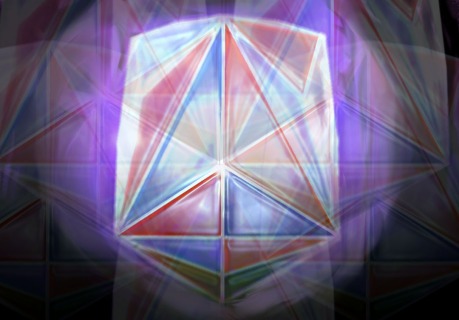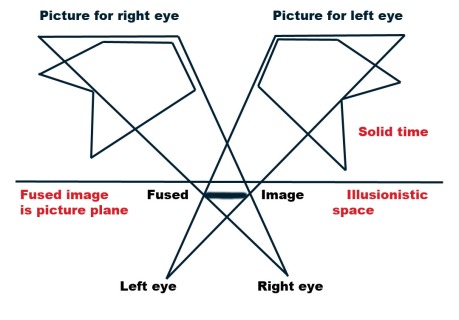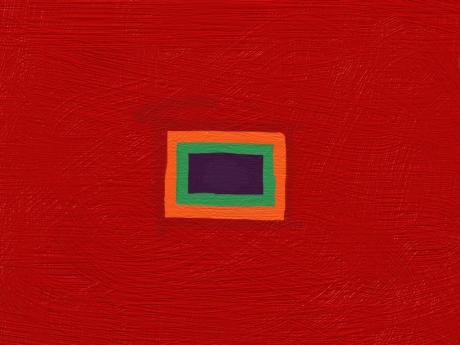Sense, Nonsense and Mysticism
December 5, 2009
“The limits of my language are the limits of my world.” – Wittgenstein
Actuality has little to do with making sense and more to do with accepting nonsense. Making sense is an activity that operates with 4-dimensional syntax and grammar (usage). Logic (syntax and grammar) is a sequential (time) contextual (space) analysis – it is the rules “behind” making sense. The limits of these rules – their boundaries – confine a sign and separate it from its context of signs, charging the symbol with meaning through its usage. Logic gives form in an otherwise “undifferentiated mass of organic sensation”. Without the form of a sign, it would have no meaningful content, but would rather be a powerless shape in a context of sameness. There is a logical limit on the expressive power of languages. What is beyond these limits is nonsense. That is not to say that it is insignificant, but rather inexpressible. The nonsense is something logic cannot limit. It is either an infinity or a paradox that dissolves logic and all hopes of making sense. The causal (sequential) way of interpreting the world is an active way of interpreting the world. The passage of time is continuous, flowing and progressive. Growth and decay are continuous, fluid movements. This way of thinking of time, as Smithson pointed out, is a practical, active way of thinking about time, but has little to do with the impractical actuality of time – the present. The present is unobtainable by any logical means. This does not necessarily entail that it is unlimited, infinite and void. (which Smithson might ascribe to the present) But if time were a place where events happened, the active (logical) event would cease to happen as soon as it happened. The present – the actual – is a space without limits… it is a space apart from logical (limited) expressive meaningful space. It is an incomprehensible infinity of possibilities where there is no correct or incorrect. It is a meaningless context of sameness… unobtainable. The present is inactive. There is no movement in an instant of time. It is a pause between the future and the past.
“The future criss-crosses the past in an unobtainable present.” – Smithson “Quasi-infinities of a Waning Space” Logic cannot obtain the present. Feeling cannot seize the present.
The inactive present avoids logic and experience because it has no limits. What we experience is the future criss-crossing the past. This is an active, expressive time with limits that change. It can be mapped. Progression and evolutionary notions of time turn into logical (epistemic) tools to map action. This time makes sense. Using this time, the world makes sense. Without this active time, there is no sense to be made. It is, as Smithson suggested, an infinite void of sameness – no limits – no form – nothing to make sense out of. Logic requires active, continuous time. It is fundamental to thinking. This is not to say that all of our provisional theories are wrong. They are correct. But they are only correct because they are within the limits of logic. There is no correct or incorrect outside the limits of language and logic.
The interpretations of actuality have infinite possibilities, none of which are correct or incorrect. There are historically contingent provisional theories built on logical, fallible foundations that cannot be proven correct or incorrect because the foundation (axiom) floats without context. There is no map of the map. The world described is limited by the epistemic tools at hand. The world felt is limited by the glass (sensing) body. The nonsites eliminate the body from setting up limits, to let the world set the limits.
Material Symbols
January 25, 2009

In anything with potential, or expressed material power, it seems to me that it is the opposing dissimilarities within their context that illuminate the matter into it’s powerful expression. Whether it be printed matter – some symbols on a page, a landscape (natural or architectural), a motion picture, or a belief etc., it is the disparates of the relative matter that surge it with expressive power. Symbols on a page, only have phoenetical or conceptual meaning because of the angular and (more generally) spacial irregularities in the symbolic context itself. The “H“, made of “l” “–” and “l“, are nuetral, and powerless if isolated away from the context of “H“, or (further) “Home”, or (even further) “Homeplate is riddled with cleat marks and wet with dirt.” It becomes a mute set of symbols that are not even phoenetically powerful. However, when the “I” “–” “I” of an “H” are pieced together in a context (which it can never not be), the symbol grows in strength into an expressive entity because of the angular “disagreements”. The symbolic mind, if looked at this way, becomes a recognition of opposing forms that illuminate the symbols into expressive entities. The recognition is not in the similarites, but in the dissimilarities. We read and interpret through the spatial variations of oppositions in the material. The perception of where these oppositions are, spatially, I think, give bias its relative character. The normative (rule-following) mind is hinged on the “inner eye” seeing this material, spatial play. The normative mind is following spatial rules, seen by the eyes. The symbolic structure of a letter, word, sentence, paragraph, chapter, book, desk, room etc., is only recognizable by the rule-following mind because of the depth perception of the eyes. The symbols only become rules to follow after the perception of the the spatial play of the symbols through the eyes perception of opposition. Or, in other words, the oppositions percieved by the eyes give form content. The content is then interprested and evaluated by the mediator of the normative.
To speculate, I imagine the material symbols come from a type of synesthesia of seeing the sounds, and then representing the sounds as sights. A backwards logic is used when then translating the sights of symbols into sounds and images, respectively. Reading (interpreting and evaluating through the normative) is a spiraling process that is set into motion by the consistent reversals of translating sounds to symbols and back again. It is a material process that rotates on an axis of depth perception.
Speculation aside, and propositionally focused – perceptual opposition in matter gives symbols their expressive power.
Optical Actualities
January 16, 2009
Enantiomorphic Purple light – a suggestion

Trisoctahedron crystal symmetry

The three-dimensionality of the Necker cube is an actual three dimensional space, when considering the stereoscopic optics of the eyes. The necker cube and other three dimensional “optical illusions”, are actually three-dimensional. The enantiomorphic (or stereoscopic) vision, is an unresolved tension between disparate dissimilars (like words or lines) that only become three dimensional, when the literary mind is suspended from the stereoscopic vision of the eyes. We can see this, because the abstract lines of the necker cube refer to nothing. They are uncontaminated by “concepts”. It might be said, that they enter the eyes without entering the mind. It only becomes more apparantly three-dimensional, when the content (or the literary mind) no longer has any power over the abstract…
Smithson actually describes his enantiomorphic vision as stereoscopic vision here:
Smithson’s Steoscopic Vision:
“The dual Globes that constitute our eyes are the generators of our sense of the third dimension. Each eyeball contains a retina that functions like a photographic plate inside a spheroid camera. Rays of light penetrate the transparent cornea, the pupil, the crystalline lense and the vitreous body until they reach the end…[The eyes] percieve through a mental artiface of directions without determined distances, which in turn gives the illusion of infinite spaces… The binocular focus of our eyes converges on a single object and gives us the illusion of oneness, so that we tend to forget the actual stereoscopic vision of our eyes or what I will call ‘enantiomorphic vision’ – that is seeing double… In [Enantiomorphic Chambers – a work of Smithsons], the vanishing point is split or the center of convergence is excluded, and the two chambers face each other at oblique angles, which in turn causes a set of three reflections in each of the two obliquely placed mirrors. A symmetrical division into two equal parts is what makes it enantiomorphic; this division also exists in certain crystalline structures” – Smithson, “Pointless Vanishing Points (1967)” (my “enhancements”)
The thing that I find interesting is that the illusion of oneness, is a “binocular convergence on an object”. It is a type of binocular focus, an adjustment of the “vitreous body” to make literal sense out of an actual stereoscopic vision. It is the literal sense of vanishing points, upon convergence of the eyes, that allows us to see the objects as whole, when (for Smithson at least) the objects were “pointless”, arrayed in symetrical reflections in the enantiomorphic chambers of the eyes. In this nonsite, or indoor earthwork by Smithson, the subtraction of the literalness of vision – the act of binocular communion on an object is taken out. What is left, is actual stereoscopic vision. This was, in part, the significance of the crystalline for Smithson.
The coheseive focussed literalness is an interference of the analytical mind, to use my vocabulary, whereas the actual mirrored geometries of enantiomorphic vision are not coheseive. The literal points – the illusory morphology of the landscape – become pointless. This is an enantiomorphic vision, where the mirrored oblique reflections form perfect symetries, where the literal points of reference shatter into an array of matter, with no reference points. Without the literal (analytical) mind, the vanishing points, the communion of objects disintegrates. The object is no longer a whole, but an array of perfectly symetrical refractive and reflective light, like in certain crystal structures. The enantiomorphic vision is “foundational” to Smithson’s aesthetics. It is a way of seeing without the literal mind interfereing. (see above post # 382 on literalness) This is stereoscopic vision – the actual. For every point in the illusory infinite space (an infinite number of literal points), the points, when viewed enantiomorphically (or stereoscopically) disintegrate every point into two. It is an unfeasable image. But the literal mind is feasable as the “fused image” in stereoscopic vision, as James P. C. Southall diagrams in his, Introduction to Phisiological Optics (1961):

Smithson’s superimposed notes are in red. (I had to reproduce this in photoshop, because the internet didn’t supply the image for me.)
The “illusionistic space” is the fused image, if you consider this diagram. The fused image is the picture plane, or the stereoscopic vision combined. This is an illusion. The note “solid time” is where the images are enantiomorphed into seperate “pictures”. Although, Smithson’s stereoscopic vision differs from this one, in that the literal mind, when suspended from vision, does not result in pictures, but oblique angular refractive, symetrical reflections of light that double the already infinite vanishing points. The fused image of the photographic eye, and the literal mind, make the seen world appear cohesevely as a whole of infinite points, where the enantiomorphic vision allows the world to appear as an infinite number of “double points” making the world no longer appear cohesive at all, but rather ambiguous, and scattered.
So literacy, is an illusory impediment of the mind onto the senses. But, when one looks at things without reading them, without a categorical containment of the mind, it becomes a three-dimensional power struggle because of the disparate dissimilars in the enantiomorphically seen world. So, two dimensions is the illusion, considering that it is a product of the interference of the literary mind with the eyes. And three dimensions is the actual, considering it is percieved when the literal mind is lifted.
Climb Back Up the Ladder
January 13, 2009
Stable Two-Dimensional Animated Three-Dimensions

I hope for immediate access to the scale of experience. I think (and I’m not alone on this) we are getting further from experiencing the scale of the eye and the ear, as one “descends”, or “ascends” the ladder of the analytical, technological mind – the two-dimensional mind. Language seems to strengthen the analytical mind that almost pulverizes the eye and ear to a death. This is to say, only, that we are moving away from the experiential scale of the eye and the eear – not to say becoming closer to the “thing-in-itself”. The experience of the enantiomorphic eyes and ears are in an inextricable, paradoxical relationship between the expressive power of the “thing out there”, and the expressive power of the eye and ear (and even the analytical mind for that matter). This makes experience, an inseperably intertwined “loopy” or spirialing paradoxical seizure, or apprehension (not an understanding) of expressive-impressiveness. It is both expressed, and impressed at the same time. The analytical mind rejects these paradoxes of the eye and ear, because it is calibrated to another scale(s). These scales are rendered uni-directionally causal.
The articles “the”, “is”, “has”, as well as present tense nouns like, “runs” “walks” etc… create, I think, a belief in stability, and present moments that could be frozen. This, however, is a result of the technological scale that language operates in. It is not the scale of the eye and ear. It is the scale of the analytical mind. The freezing of moments into two-dimensional pictures of memory, has scaled the mind down to a place where the cybernetic exists – a place far from the senses, that makes us cyborgs. We are human-machine, because of the practical power of the analytical two-dimensional maps. They have nearly destroyed all belief in reality. The project of art and peotry is to bring back a lost belief in reality – a lost scale.






